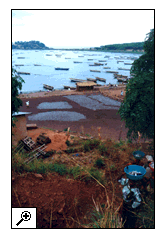|
|
 |
|
Within the various project components, a great deal of work has been done that will help us understand the lake, the threats to its integrity and the relationship of these, to the people that depend on it.
So often, this is where many projects end! The step of converting the acquired technical information into management action is not bridged or is done so in an unsatisfactory manner. 
The Lake Tanganyika Biodiversity project has bridged that gap thanks to the four countries' collaboration in the development of the Strategic Action Programme.
Simply stated, the Strategic Action Programme (SAP) is a participatory strategic planning process to enable scientists and natural resource managers to identify and prioritise their management initiatives for the Lake.
A notable achievement of this project has been the level of participation in the development of the SAP and the clear logical step-by-step methods used. Following a series of planned meetings by the National Working Groups, participants, from all the stakeholder groups, looked at the threats to the lake from the 'national' perspective. This is, of course, the natural and more familiar way to look at these issues. Each country carried out a national sectoral problem review. This was followed by the first Transboundary Diagnostic Analysis (TDA), which is really the heart of the SAP, as it concentrates on the regional or transboundary impacts of each countries activities that affect the lake.
|